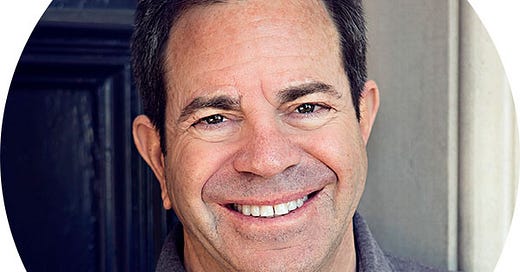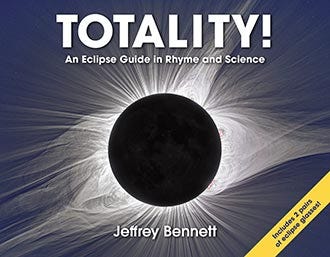As a kid growing up in Columbus, Ohio, observing outer space from afar was an endless source of fascination. I have fond memories of mom taking my brother and me to the planetarium at COSI, the largest of its kind in Ohio. For hours, we’d marvel at the stars, planets, and the farthest reaches of the galaxy.
In my later years I have become a bit of a curmudgeon, having lost a bit of my interest when it comes to star and planet gazing. Now I’m thinking I should reconsider this in light of some exciting solar events projected for 2023 and beyond.
Tens of millions came out to take in the 2017 solar eclipse, the first in the U.S. in nearly four decades. Now we’re on the precipice of a pair of upcoming eclipses: an annular eclipse on October 14, 2023, and a total solar eclipse on April 8, 2024.
It’s here where I was recently introduced to a book entitled “Totality: An Eclipse Guide in Rhyme and Science” by Jeffrey Bennett. This unique guide features a cool combination of rhyme and science that makes it suitable for a variety of ages. Even cooler is that the rhyme has been pedagogically created to educate readers on the underlying science with illustration and “Big Kid Box” sidebars.
The book concludes with a glossary, suggested activities, and an eclipse science summary — features that deliver value for parents and teachers wanting to learn along with their students and kids.
The brainchild of Jeffrey Bennett, an astrophysicist and educator who has storied history in math and science education, TOTALITY, is his 7th book for children. It joins his 6 previous children’s books as selections for the Story Time From Space program, where astronauts aboard the International Space Station read books to children of Earth.
What was the major inspiration behind your decision to write “Totality: An Eclipse Guide In Rhyme and Science?”
JB: As an astronomer with a career focused on educational outreach, eclipses provide an extraordinary opportunity to reach a lot of people, since millions of people are at least temporarily drawn in by an astronomical event. So my major goal was to use upcoming eclipses to inspire people about science more generally.
I initially tried to write this book before the 2017 eclipse, to go along with my free Totality app, but I couldn’t get the rhyme to work to my satisfaction. So I put it aside and returned to it last year. This time, with the help of many friends (names listed on copyright/credits page), I got it to work well enough to seem worth moving forward, which is how the book came to be.
Who is the book primarily targeted to?
JB: In terms of audience, while it’s ostensibly a children’s book, I hope it will be read by grownups as well. The real goal of the rhyme is to serve as a mnemonic device, with the key content coming through the Big Kid Box sidebars and the illustrations,
Why do you believe so many of us are fascinated with solar eclipse events?
JB: Historically, fascination with eclipses was probably based largely on the shock value of the Sun disappearing in the daytime. As described on p. 9 of the book, this was often a frightening event for our ancestors. Today, the fascination is tied more to the spectacle itself. Anyone I know who has seen a total eclipse has come away with a great sense of awe. And from a science perspective, what I wrote in the box on p. 9 is the key, in that the way in which we’ve used science to turn an ancient fear into empowerment should inspire us to use science in other ways that can provide benefits to all humankind.
What do you believe all of this says about human nature?
JB: As with the night sky, eclipses provide us with a reminder that we are connected to the larger universe. While each person assigns their own meaning to this connection, I believe human nature makes it inevitable that everyone will experience at least some sense of wonder and awe as they look up at the Sun, Moon, and stars — a sense that will be amplified when all these things come together during a solar eclipse.
What will be the biggest difference between the 2023 and 2024 eclipses?
JB: The big event is the total solar eclipse in 2024, when the moon will completely block the Sun along the path of totality. During totality, it will become dark enough to see the planets and bright stars, and you’ll be able to remove your eclipse glasses to see the eclipsed Sun surrounded by its spectacular corona (atmosphere). The 2023 eclipse will be annular, which means it occurs at a time when the Moon is farther from the Earth in its orbit. Therefore, it won’t completely block the Sun. Instead, it will appear in front of the Sun but surrounded by a ring (or “annulus”) of sunlight. This means it won’t get completely dark during the 2023 eclipse, and also means that you will need eye protection at all times to look towards the eclipsed Sun.
What will be needed to see this eclipse safely?
JB: An inexpensive pair of eclipse glasses makes it possible to look at the Sun throughout the eclipse. ( In fact, you can use eclipse glasses to look safely at the sun at any time). Just remember two key points: (1) Be sure that you get your eclipse glasses from a reputable source, such as those vetted by the American Astronomical Society (listed at eclipse.alas.org). Or you can use the glasses included in my book Totality! An Eclipse Guide in Rhyme and Science; (2) You should never look up at the Sun without your eclipse glasses except during totality, when you can and should remove them.
What is your greatest hope in terms of what readers walk away from your book with?
JB: I’d say two things: First, I hope many readers will seek out the experience of totality, either by finding some way to get to the path of totality for 2024 or by planning for some other future eclipse. Second, and more important, I hope that readers will recognize in the aforementioned idea that science can help us change fear to empowerment. All of this with the aim of inspiring us to try to learn more about other things science can help us do, such as learning how to understand and address climate change, learning how we can use science to improve the lives of people around the world, and so on.






